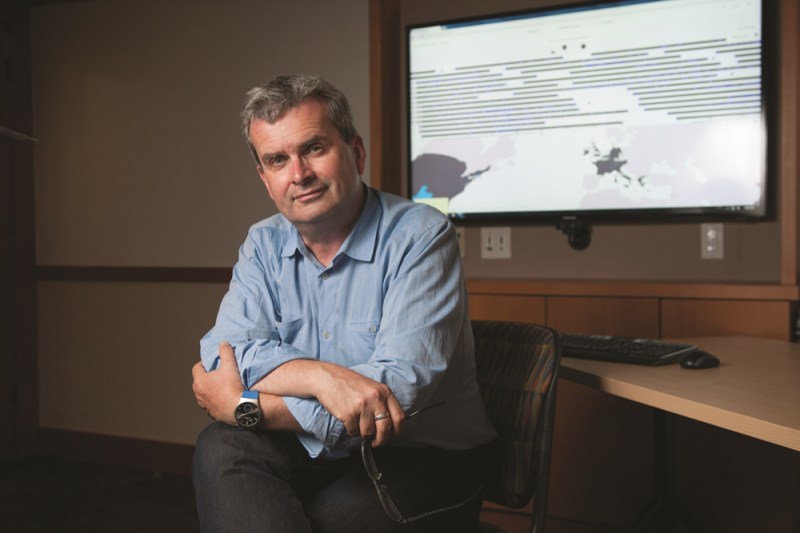
The Program in Writing and Rhetoric (PWR) will launch its new Notation in Science Writing program this winter quarter in an effort to help science and engineering majors develop their communications skills.
According to Nicholas Jenkins, associate professor of English and faculty director of PWR, the Notation—intended for sophomores and juniors—follows the national movement of universities offering certificates and other supplements to the traditional college degree. Jenkins believes that this trend is especially relevant to science fields.
“Interdisciplinary communication between scientists is itself a challenge now because the fields are so different,” Jenkins said.
He explained that planning for the science Notation program began about two years ago. Coinciding with the values of the Study of Undergraduate Education at Stanford (SUES) report, the Notation emphasizes flexibility in its requirements and curriculum.
“One of the things that we were aware of is that a lot of majors in the sciences and engineering are very unit-heavy so the requirements are arduous,” Jenkins said. “There are classes that we ask people to take for the Notation, but we try to keep it to a minimum.”
Participants will create an ePortfolio with the help of individual advisors in PWR and in their majors’ departments. Incorporating classwork and students’ personal reflections, the portfolio acts as the final capstone assessment and will remain in the Stanford digital repository following completion of the program. Except for two required one- or two-unit classes at the beginning and end of the program, students can choose the courses they want to count toward the Notation.
“We’re not trying to micromanage what students take,” Jenkins said. “If you’re a computer scientist, for example, maybe there’s a course in electrical engineering that looks like it might have a good applicability to the Notation…as long as your advisor approves, you can count it for the Notation.”
Advanced PWR courses centered on science communication and geared to qualify for the Notation will also be offered this winter quarter.
Jennifer Stonaker, a PWR lecturer, will be teaching a new class PWR 91JS: Intermediate Writing: Stanford Science Podcast, in which students will act as journalists and interview professors and researchers around campus.
“My goal is to talk a little bit about audience. Scientists have to speak not just to their colleagues but also the general public,” Stonaker said. “We can decide…how to target our content to reach that type of audience.”
Stonaker, who said she enjoys listening to science podcasts in her free time, earned her Ph.D. in plant biology and genetics and has firsthand experience in both science research and education. She explained that the curriculum will focus on how to produce and edit podcasts, and the final products will be available to the public.
“I don’t really know how many other podcasting classes in general are being taught, but it’s definitely not at Stanford or at other universities,” Stonaker said. “It’s fun to design from basically the ground up and see how it goes.”
Although there is currently no cap on the number of students PWR will accept into the Notation program, Jenkins hopes the program will start small to give students more individual attention.
“We see this as being a template for Notations that could be in other fields in the University as well,” Jenkins said. “We wanted to start with the sciences and engineering because I think most people would say that’s where the greatest gap usually is between the amount of writing you have to do in one of those majors, and the amount of writing that might be helpful for you.”
Jenkins explained that once a student has completed the Notation, the “Notation in Science Writing” would appear on the participant’s transcript.
“Companies look for people who have strong communication skills, so I hope that [the Notation] will make Stanford students more marketable,” Jenkins said.
Jenkins also explained that PWR wants the program to be accessible to students of all communication skill levels.
“Our goal is to help you become a better communicator,” Jenkins said. “Whether you’re an unconfident scientist communicator or you’re a very confident one who’d like to get better, our Notation will apply and be relevant to you, whoever you are.”
While it is still too early to gauge student interest, Associate Director of PWR Zach Waggoner said he has been receiving inquiries about the program.
“I’ve fielded some emails, students expressing interest, wanting to know a little bit more,” Waggoner said. “We have a few information sessions coming up, so I’m giving them a little bit more information but also then encouraging them to attend our Q&A sessions coming up in Hume Center.”
Interested students can attend the open-house information session on Wednesday, Oct. 30, at the Hume Writing Center for Writing and Speaking. Applications for the Notation close at 5 p.m. on Nov. 1. Applicants will be notified of the results on Wednesday, Nov. 13.
“I believe in the power of communication,” Jenkins said. “I strongly believe that words and speech and visual rhetoric are things everybody in the University has a stake in, and this Notation is designed to help people claim ownership of those powers.”
Contact Kylie Jue at kyliej ‘at’ stanford.edu.
